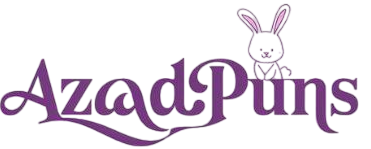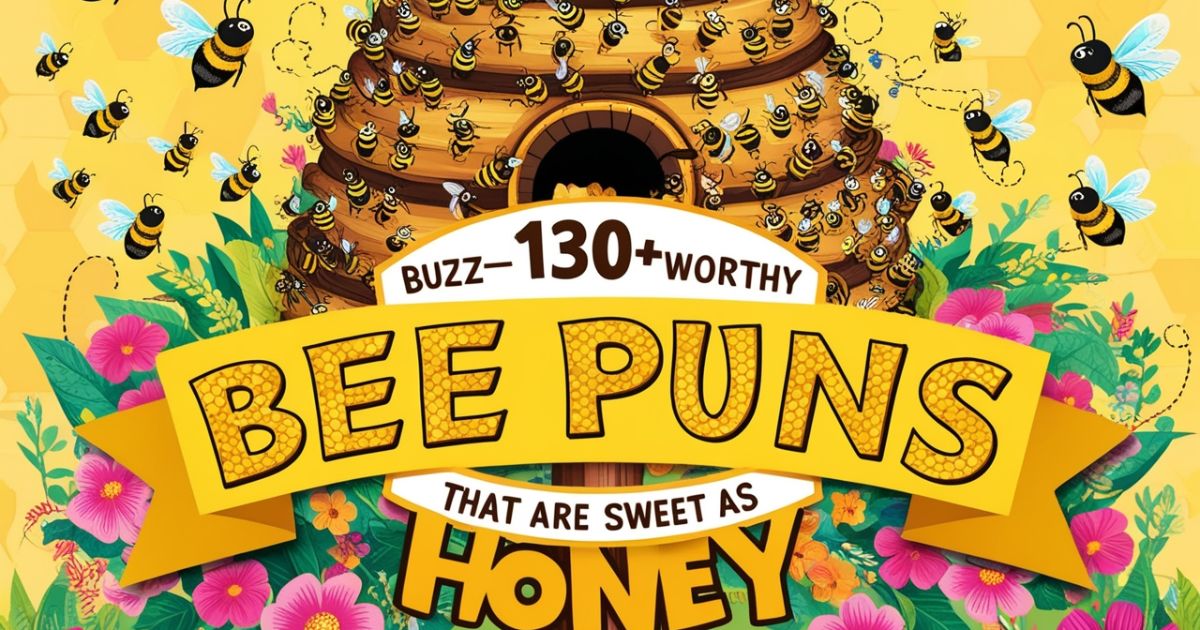Bee puns represent a delightful intersection of humor, wordplay, and our collective appreciation for one of nature’s most remarkable creatures. Whether you’re looking to sweeten someone’s day with a light-hearted joke or add some honey-flavored charm to a special occasion message, this comprehensive guide will equip you with the perfect bee-themed wordplay for every situation.
Introduction: Why Bee Puns Create Such a Buzz
Bee puns have maintained enduring popularity across generations due to their versatility and inherent charm. The English language provides numerous opportunities for bee-related wordplay through homophones (be/bee), prefixes, and the rich vocabulary associated with bees and their behavior.
These clever plays on words resonate with people because they combine familiar concepts with unexpected twists, creating moments of surprise and delight. The universality of bee imagery—industriousness, community, sweetness—provides rich metaphorical ground for developing meaningful yet humorous expressions.
Research shows that wordplay like puns activates multiple areas of the brain simultaneously, creating a cognitive “reward” when we understand the dual meanings. This explains why a well-crafted bee pun can elicit both groans and smiles, making these funny bee sayings perfect for breaking the ice or lightening tense moments.
The Science of Sweetness: Understanding What Makes Bee Puns Work
Effective bee puns typically employ one or more of these linguistic mechanisms:
- Homophone substitution: Replacing “be” with “bee” (Example: “Just bee yourself!”)
- Word blending: Combining “bee” with another word (Example: “un-bee-lievable”)
- Semantic association: Using bee-related terminology metaphorically (Example: “The buzz around town”)
The most successful bee jokes strike a balance between predictability and surprise. They must be recognizable enough to establish the bee connection while offering an unexpected twist that rewards the listener. The multi-layered nature of these puns engages our problem-solving abilities and creates a sense of shared understanding when comprehended.
Psychologists have found that appreciation for puns correlates with higher verbal intelligence and creative thinking, suggesting that both creating and enjoying bee wordplay exercises valuable cognitive skills.
“A well-timed pun is not just a joke; it’s a demonstration of linguistic dexterity and cultural awareness.” – Dr. Richard Wiseman, Psychologist and Author
Honey-Coated Classics: Essential Bee Puns for Every Occasion
These foundational bee puns serve as versatile expressions suitable for various contexts and conversations:
- “You’re the bee’s knees!”
- “Mind your own beeswax.”
- “Bee yourself!”
- “To bee or not to bee.”
- “Bee-cause I said so!”
- “Don’t worry, bee happy.”
What makes these classics so effective is their simplicity and immediate recognition. They leverage common phrases where “be” can be playfully substituted with “bee,” creating instant wordplay that requires minimal explanation.
These expressions have become so integrated into popular discourse that many people use them without consciously recognizing the pun—a testament to their effectiveness and staying power as clever bee puns.
Bee-yond Ordinary: Advanced Wordplay for Pun Enthusiasts
For those who appreciate more sophisticated witty one-liners about bees, these advanced puns demonstrate greater linguistic complexity:
- “I’m experiencing a case of hive anxiety.”
- “That joke really stung.”
- “Let’s comb through these options carefully.”
- “You’re really pollen my leg with that story.”
- “I can’t bee-lieve we’re having this conversation again.”
- “She’s always drone on about her problems.”
Advanced bee puns often incorporate multiple layers of meaning and require deeper knowledge of bee terminology. For example, understanding that a “drone” is a male bee adds an extra dimension to jokes playing on the homophone with the verb “to drone” (speak monotonously).
Mastering these more nuanced expressions demonstrates linguistic sophistication and creates opportunities for more memorable interactions. They often elicit stronger reactions precisely because they require more cognitive processing to appreciate fully.
Buzzing with Laughter: A Hive of Bee Puns to Sweeten Your Day
These uplifting bee puns serve as perfect mood boosters for everyday situations:
- “You’re creating quite a buzz around here!”
- “Let’s bee reasonable about this.”
- “I’m pollen in love with this idea.”
- “That’s the nectar of wisdom right there.”
- “Stop waxing poetic and get to the point.”
- “We need to hive a serious talk.”
Research by the Mayo Clinic suggests that humor can reduce stress, stimulate organ systems, and boost immune function. Incorporating these light-hearted expressions into daily conversations can create moments of connection and levity even during challenging times.
These expressions work particularly well when unexpectedly inserted into otherwise serious discussions, creating cognitive contrast that enhances the humorous effect. Their versatility makes them suitable for both personal and professional contexts when delivered with appropriate timing.
Bee-lieve It or Not: Puns That’ll Make You Buzz with Joy
These motivational bee quotes combine inspiration with humor:
- “Bee-lieve in yourself and anything is possible.”
- “Always bee the hardest worker in the room.”
- “Bee the change you wish to see in the world.”
- “Success comes to those who are too buzzy to look for it.”
- “Good things come to those who buzz around for them.”
- “You can’t have a rainbow without a little buzz first.”
These expressions effectively combine the industrious, cooperative nature of bees with motivational messaging. The wordplay softens what might otherwise feel like trite advice, making inspirational concepts more accessible and memorable.
In professional development contexts, these expressions can serve as mnemonic devices for important principles. Their dual nature—both humorous and meaningful—makes them effective tools for conveying wisdom in a more approachable manner.
Buzz-Worthy Bee Puns for Names
Transforming well-known names into bee-themed wordplay creates instantly recognizable humor:
- Buzz Aldrin (already bee-adjacent!)
- Bee-nedict Cumberbatch
- Bee-atrix Potter
- Bee-ll Murray
- Bee-llie Eilish
- Bee-ll Gates
- Bee-njamin Franklin
- Bee-ll Clinton
- Bee-llie Holiday
- Bee-ll Nye the Science Guy
- Bee-llie Jean King
- Bee-llie Joel
- Bee-llie Crystal
- Bee-llie Piper
- Bee-thoven
- Bee-yoncé
The effectiveness of these celebrity bee puns lies in their immediate recognizability. The original name must remain sufficiently intact to be identifiable, while the bee element should integrate smoothly rather than feeling forced.
These name-based puns often create stronger reactions than generic wordplay precisely because they reference specific cultural touchpoints. They can serve as excellent icebreakers or thematic elements for events, particularly when chosen to reflect the interests of the audience.
Professional Pollination: Using Bee Puns in Business and Marketing
Thoughtfully applied bee puns can enhance brand memorability and customer engagement:
- “Let’s bee in touch soon.” (Email signature)
- “Our team is always buzzing with new ideas.” (Company description)
- “The sweet solution to your business challenges.” (Service offering)
- “Creating quite the buzz in the industry.” (Testimonial headline)
- “Honey-ed words backed by solid results.” (Marketing material)
Many successful businesses have incorporated bee imagery and wordplay into their branding, from Bumble (dating app) to Burt’s Bees (personal care products). The positive associations with bees—productivity, cooperation, natural goodness—transfer effectively to commercial messaging.
When implementing bee puns in professional contexts, subtlety is key. The wordplay should enhance rather than distract from the core message, serving as a memorable hook rather than overwhelming the substantive content.
| Business Sector | Effective Bee Pun Application |
| Food & Beverage | “The sweetest deals in town” |
| Technology | “Technology solutions that bee-have exactly as promised” |
| Healthcare | “Bee well with our comprehensive care approach” |
| Education | “Where young minds buzz with possibility” |
| Finance | “Making your money work as hard as a bee“ |
Buzzing with Birthday Cheer: Bee Puns for Your Special Day
Birthdays represent perfect opportunities for bee-themed celebratory messages:
- “Bee-lated or on time, here’s wishing you a sweet birthday!”
- “Hope your special day is creating quite the buzz!”
- “Another year older, another year wiser – you’re truly the bee’s knees!”
- “Hive a wonderful birthday celebration!”
- “May your birthday bee filled with all the honey-ed moments life has to offer.”
Birthday wishes featuring bee birthday wishes create a distinctive alternative to conventional greetings. The playful nature of these puns brightens the celebratory tone while demonstrating thoughtful creativity from the sender.
These expressions work particularly well on greeting cards or social media posts, where their visual components can be enhanced with bee-themed imagery. The combination of verbal and visual elements creates a more cohesive and memorable birthday message.
Buzzing with Christmas Cheer: Bee Puns for the Holidays
Seasonal celebrations gain extra charm with these festive bee humor expressions:
- “Bee merry and bright this holiday season!”
- “Wishing you a honey of a Christmas!”
- “May your holidays bee filled with joy and wonder.”
- “Hive yourself a merry little Christmas!”
- “Sending buzzzes of holiday cheer your way!”
The winter holiday season, paradoxically distanced from actual bee activity in nature, creates unexpected delight when combined with bee imagery. This cognitive contrast makes these puns particularly effective for standing out among more traditional seasonal greetings.
For holiday bee jokes to work effectively, they should acknowledge both the bee theme and specific holiday traditions. This dual reference creates richer wordplay and demonstrates greater creativity than single-dimensional puns.
Spook-Bee-tacular Halloween Puns
Halloween provides rich territory for bee-themed wordplay with these Halloween bee puns:
- “What do you call a haunted hive? A boo-hive!”
- “Why did the bee wear a ghost costume? To give everyone a boo-bee fright!”
- “What’s a bee’s favorite Halloween movie? The Bee-tlejuice!”
- “Why did the vampire refuse to bite the bee? Too much buzz in the blood!”
- “What do you call a bee who loves telling scary stories? A boo-bard!”
The contrast between the traditionally sweet, productive image of bees and the spooky elements of Halloween creates particularly effective humor. These jokes work through unexpected combinations of distinct conceptual domains.
Halloween’s emphasis on costumes and transformation aligns naturally with wordplay that transforms ordinary bee concepts into spooky variations. The resulting spooky bee jokes appeal to both humor and the seasonal spirit of playful fright.
Bee My Valentine: Sweet and Buzzing Love Puns
Romance blooms with these romantic bee puns:
- “Will you bee mine?”
- “You’re the queen of my hive.”
- “I’m pollen in love with you more each day.”
- “Our love was meant to bee.”
- “You make my heart buzz with joy.”
- “Together, we make quite the hive of happiness.”
Valentine’s Day expressions benefit particularly from bee-themed wordplay due to the natural associations between honey, sweetness, and romantic sentiment. These connections create multi-layered meanings that enhance the emotional impact of the messages.
The metaphorical parallels between bee behavior and romantic relationships offer rich material for wordplay: the queen bee and her devoted workers, the cooperative nature of the hive, and the production of something sweet through collective effort all serve as powerful analogies for human partnerships.
Educational Nectar: Teaching Language Skills Through Bee Puns
Educators can leverage bee puns as effective teaching tools for language development:
- Homophone recognition: “be” vs. “bee“
- Prefix modification: “un-bee-lievable”
- Metaphor comprehension: “buzzing with excitement”
- Cultural literacy: Understanding references like “the bee’s knees“
Research in educational psychology suggests that humor enhances student engagement and information retention. Incorporating bee trivia and puns into language lessons creates cognitive hooks that make learning more memorable and enjoyable.
For younger learners, bee puns can serve as entry points to understanding more complex linguistic concepts. The concrete imagery associated with bees provides accessible mental scaffolding for abstract language principles.
“Wordplay doesn’t just entertain—it illuminates the flexibility and creativity inherent in language acquisition.” – Dr. Ellen Winner, Psychology of Language Researcher
Cultural Cross-Pollination: Bee Puns Around the World
While this guide focuses primarily on English-language bee puns, similar wordplay exists across cultures:
- French: “Être ou ne pas être” (To be or not to be) becomes “Abeille ou ne pas abeille” (Bee or not bee)
- Spanish: “Abeja” (bee) can be worked into “deja” (leave) for “A-beja-me en paz” (Leave me in peace)
- German: “Biene” (bee) works with “Bühne” (stage) for theatrical puns
The universality of bees in human agriculture and mythology creates cross-cultural resonance for bee-themed humor. While specific wordplay mechanisms differ based on linguistic structure, the conceptual foundations remain consistent across languages.
Cultural variations in bee symbolism also influence how these puns are received and interpreted. In some traditions, bees represent industriousness and community, while in others they symbolize immortality or divine messaging—enriching the potential layers of meaning in bee-related expressions.
Digital Hive Mind: Bee Puns in Social Media and Memes
Bee puns have found particular resonance in digital communication:
- Hashtags like #JustBeeYourself and #UnBEElievable create searchable content categories
- Meme formats featuring bees with punny captions generate viral sharing
- Emoji combinations like 🐝 + 💭 (bee + thought bubble) serve as visual puns
The concise nature of bee puns makes them ideal for platform-constrained communication like tweets or meme captions. Their visual potential also creates opportunities for multimedia expression across digital platforms.
Social media analysis reveals that bee-inspired quotes and puns receive higher engagement rates than many other forms of wordplay, possibly due to their universal appeal and positive associations. This makes them valuable tools for content creators seeking to maximize reach and audience interaction.
Buzzing with Laughter: Bee Puns to Brighten Your Day
These quick-hit bee jokes deliver immediate humor:
- “Why do bees have sticky hair? Because they use honeycombs!”
- “What do you call a bee from America? A USBee!”
- “How does a queen bee get around her hive? She’s throne around!”
- “What’s a bee’s favorite novel? The Great Gatsby!”
- “Why did the bee go to the doctor? It had hives!”
The question-and-answer format of these jokes creates a built-in pause for cognitive processing, enhancing the humorous effect when the punchline arrives. This structure works particularly well for social interactions, creating moments of anticipation and shared laughter.
These simple bee jokes often serve as “gateway puns” that introduce newcomers to the broader world of bee-themed wordplay. Their accessibility makes them appropriate for diverse audiences, from young children to language learners to pun connoisseurs.
Conclusion: The Lasting Sweetness of Bee-Based Humor
Bee puns represent more than simple wordplay—they reflect our enduring fascination with these remarkable creatures and their prominence in our collective imagination. From motivational messages to holiday greetings, these expressions create moments of connection through shared humor and linguistic creativity.
As environmental awareness grows, bee puns also serve as subtle reminders of these pollinators’ ecological importance. They keep bees present in our cultural conversation, creating cognitive linkages that may ultimately support conservation efforts through increased awareness and appreciation.
Whether you’re a dedicated entomology humor enthusiast or simply someone who appreciates the occasional clever wordplay, bee puns offer accessible entry points to linguistic creativity. By understanding their mechanisms and applications, you can more effectively craft and appreciate these expressions in various contexts.
Remember, the best bee puns don’t just generate laughs—they create moments of connection, demonstrate linguistic dexterity, and remind us of the sweet possibilities contained within language itself. So go forth and bee creative with your wordplay!

Hello, I’m Daisy Sadie, a writer at Azaadpuns. I explore the dynamic world of puns and wordplay, delivering captivating linguistic twists that will make you laugh and groan. Join me on Azaadpuns.com for the latest in clever wordplay that makes language fun again.

